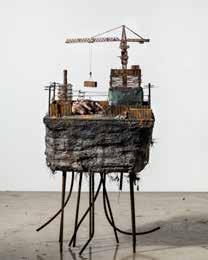
2 minute read
An Hyo Chan
written by Whit Altizer
An Hyo Chan’s sculptures look like an industrial hazard. His sculptures of construction sites feel post-apocalyptic, but perhaps reveal what we don’t see behind the high walls that surround half-constructed buildings: the waste and grittiness that gets buried for generations, or forever, under the concrete foundations of apartment buildings. There is nothing environmentally-friendly or clean about new buildings, and An’s work captures that rawness in his work.
Advertisement

생산적 미완 #3
IUF, 시멘트 , 철근 , 나무 , 오브제 , 88x57x157cm, 2018

생산적 미완 #3 (detail)
IUF, 시멘트 , 철근 , 나무 , 오브제 , 88x57x157cm, 2018
An’s materials include rusted metal, dirty chunks of cement blocks, bent rebar, and corroded pipes that gives his work a sense of filth. The buildings in his depictions look abandoned or condemned with only tiny workers infesting the piece as if they are constructing an anthill. In one piece a giant pig carcass lies lifeless in the middle of buildings under construction (or destruction) while little men work around the pig as if it is part of the project. Tower cranes hover like a foreman over the buildings in progress. In one piece the pig is suspended in mid-air, and in another the crane sits atop a concrete slab that looks like a skyscraper.

우리 안의 우리_state
IUF, 시멘트, 철근, 나무, 오브제, 61x41x132cm, 2017
The environment and animals in the pieces are clearly the victims in An’s work. The earth looks stripped and hacked, and even the foundations of the sculptures appear as if they have been retrieved from a building that has been demolished. The pigs in each piece don’t seem to have been slaughtered as much as died from the hazards of their industrial surroundings. They may have been crushed by the heavy machinery or simply unable or unwilling to live in this world. The animate and inanimate objects carry a feeling of destruction and suffering while only the humans move forward in the name of progress.

우리 안의 우리_state (detail)
IUF, 시멘트, 철근, 나무, 오브제, 61x41x132cm, 2017
An’s work could be a critique of the construction industry. An industry that runs rampant with its incessant building of high rises, new stadiums, and commercial buildings around the world. In many parts of Korea, large tracts of once thriving farmland have been sold off to the highest bidder allowing new wealth and buildings to emerge from the pure labor of broken farmers. Sometimes these buildings fill up with life, sometimes they do not. Earth that was once fertile is now contaminated by scrap metals, sludge, and chemicals. The jutaek (주택) that people leave for these newer versions of home are torn down, and people pack into high rises like livestock. When seen this way, An’s work is depressing in its accuracy.

평범한 사람들
Stuio148, 가변설치, 2018
The work is messy but it is intentional. A clean version of An’s work would be too sterile and that would be a grave inaccuracy. The work captures the greed of man, the dehumanization of the land and animals that are contaminated and displaced by that greed, and the destruction that human progress can bring. An’s work evokes the feelings one might get by seeing a beautiful rice field in spring get demolished by dirty bulldozers and replaced by a 17-floor, white monolith that casts a shadow over the land like a gravestone. There is nothing beautiful or heart-warming about that.

평범한 사람들 (detail)
Stuio148, 가변설치, 2018






